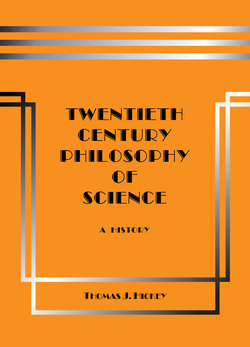Читать книгу Twentieth-Century Philosophy of Science: A History (Third Edition) - Thomas J. Hickey - Страница 58
На сайте Литреса книга снята с продажи.
3.27 Aside on Metaphor
ОглавлениеA metaphor is a predication to a subject term that is intended to include only selected parts of the meaning complex conventionally associated with the predicate term, so the metaphorical predication is a true statement due to the exclusion of the remaining parts in the predicate’s meaning complex that would make the metaphorical predication a false statement.
In the last-gasp days of decadent neopositivism some positivist philosophers invoked the idea of metaphor to explain the semantics of theoretical terms. And a few were closet Cartesians who used it in the charade of justifying realism for theoretical terms. The theoretical term was the positivists’ favorite hobbyhorse. But both realism and the semantics of theories are unproblematic for contemporary pragmatists. In his “Posits and Reality” Quine said that all language is empirically underdetermined, and that the only difference between positing microphysical entities (like electrons) and macrophysical entities (like elephants) is that the statements describing the former are more empirically underdetermined than those describing the latter. Thus contrary to the neopositivists the pragmatists admit no qualitative dichotomy between the positivists so-called observation terms and their so-called theoretical terms.
As science and technology advance, concepts of microphysical entities like electrons are made less empirically underdetermined, as occurred for example with the development of the Wilson cloud chamber. While contemporary pragmatist philosophers of science recognize no need to explain so-called theoretical terms by metaphor or otherwise, metaphor is nevertheless a linguistic phenomenon often involving semantical change and it can easily be analyzed and explained with componential semantics.
It has been said that metaphors are both true and false. In a speaker or writer’s conventional or “literal” linguistic usage the entire conventional meaning complex associated with a univocal predicate term of a universal affirmation is operative. But in a speaker or writer’s metaphorical linguistic usage only some selected component part or parts of the entire meaning complex associated with the univocal predicate term are operative, and the remaining parts of the meaning complex are intended to be excluded, i.e., suspended from consideration and ignored. If the excluded parts were included, then the metaphorical statement would indeed be false. But the speaker or writer implicitly expects the hearer or reader to recognize and suspend from consideration the excluded parts of the predicate’s conventional semantics, while the speaker or writer uses the component part that he has selected for describing the subject truly.
Consider for example the metaphorical statement “Every man is a wolf.” The selected meaning component associated with “wolf” that is intended to be predicated truly of “man” might describe the wolf’s predatory behaviors, while the animal’s quadrupedal anatomy, which is conventionally associated with “wolf”, is among the excluded meaning components for “wolf” that are not intended to be predicated truly of “man”.
A listener or reader may or may not succeed in understanding the metaphorical predication depending on his ability to select the applicable parts of the predicate’s semantics tacitly intended by the issuer of the metaphor. But there is nothing arcane or mysterious about metaphors, because they can be explained in literal (i.e., conventional) terms to the uncomprehending listener or reader. To explain the metaphorical predication of a descriptive term to a subject term is to list explicitly those affirmations intended to be true of that subject and that set forth just those parts of the predicate’s meaning that the issuer intends to be applicable.
The explanation may be further elaborated by listing separately the affirmations that are not viewed as true of the subject, but which are associated with the predicated term when it is predicated conventionally. Or these may be expressed as universal negations stating what is intended to be excluded from the predicate’s meaning complex in the particular metaphorical predication, e.g., “No man is quadrupedal.” In fact such negative statements might be given as hints by a picaresque issuer of the metaphor for the uncomprehending listener.
A semantical change occurs when the metaphorical predication becomes conventional, and this change to conventionality produces an equivocation. The equivocation consists of two literal meanings: the original one and a derivative meaning that is now a dead metaphor. As a dead man is no longer a man, so a dead metaphor is no longer a metaphor. A dead metaphor is a meaning from which the suspended parts in the metaphor have become conventionally excluded to produce a new “literal” meaning. Trite metaphors, when not just forgotten, metamorphose into new literals, as they become conventional.
